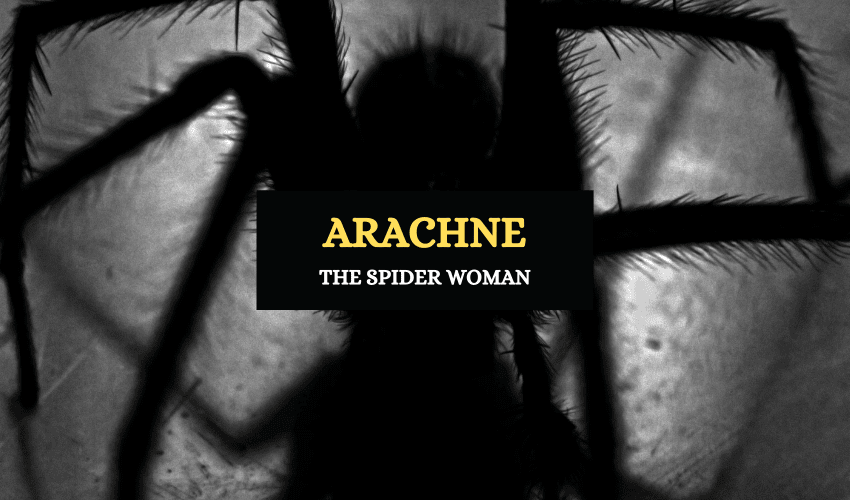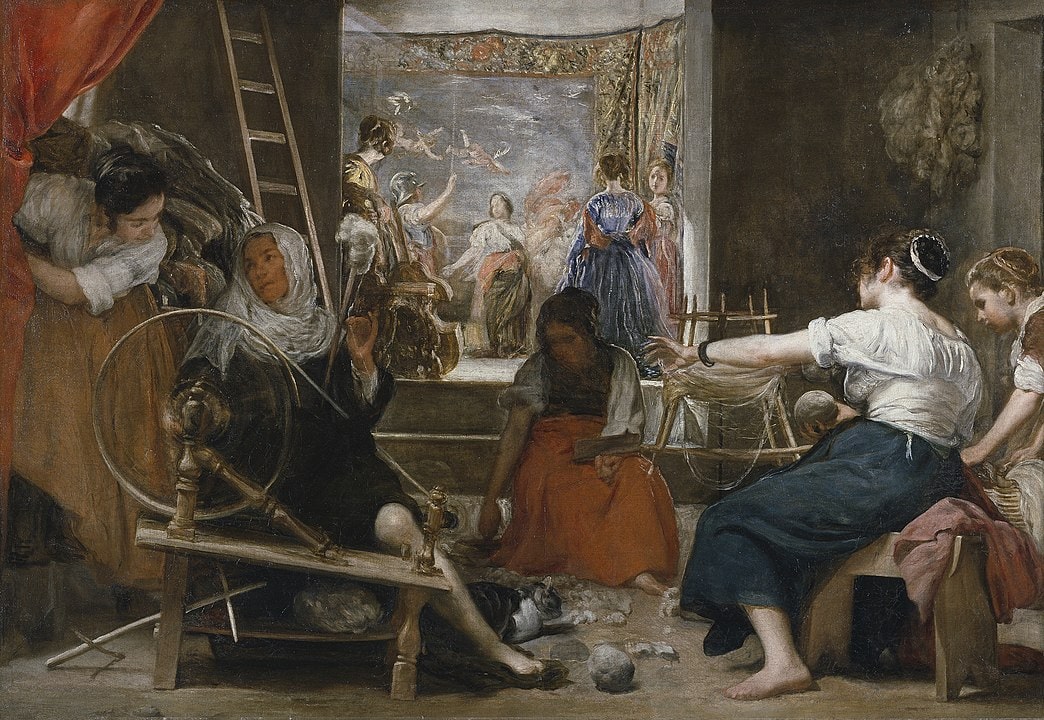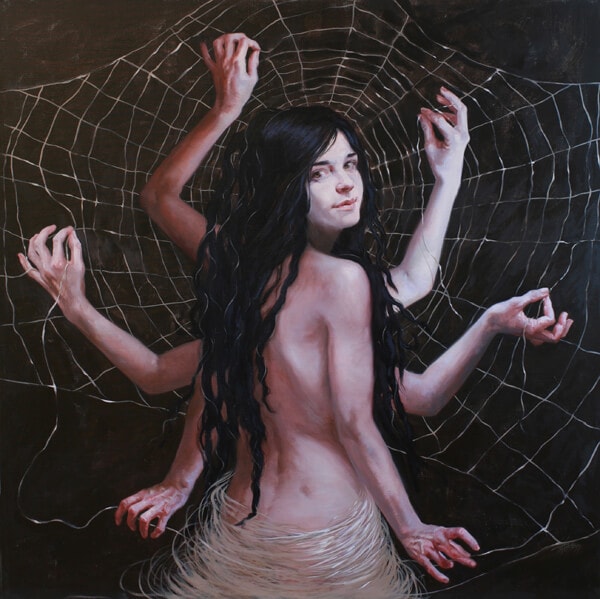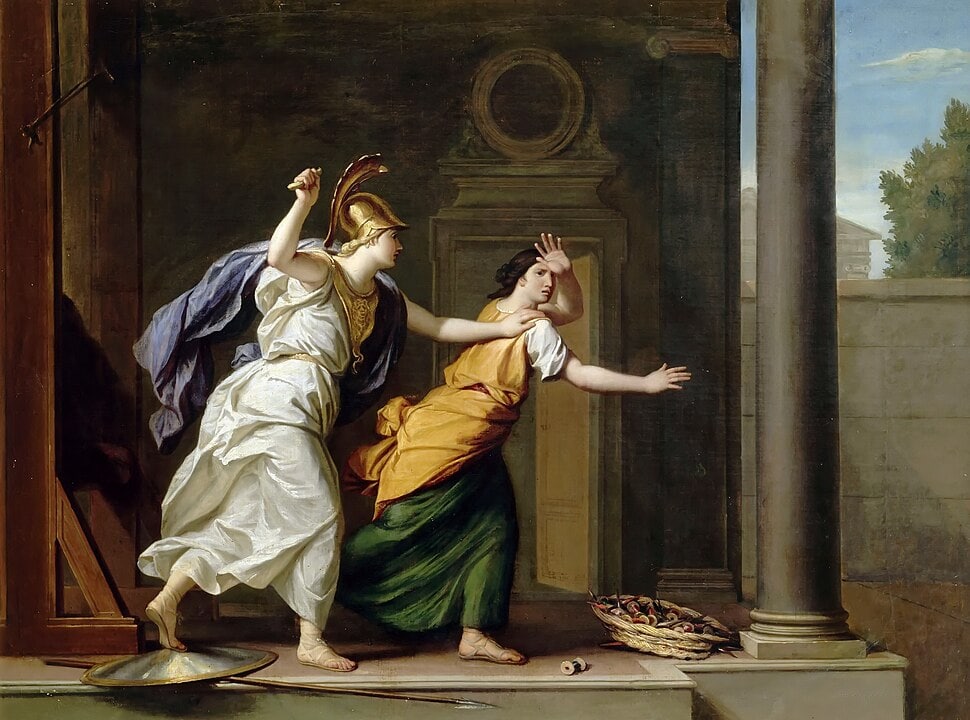
Table of Contents
Arachne was a mortal woman in Greek mythology who was an incredible weaver, more talented than any other mortal in the craft. She was famous for being boastful and for foolishly challenging the Greek goddess Athena to a weaving contest after which she was cursed to live as a spider for the rest of her life.
Who Was Arachne?
According to Ovid, Arachne was a beautiful, young Lydian woman born to Idmon of Colophon, not to be confused with Idmon, the Argonaut. Her mother’s identity, however, remains unknown. Her father was a user of purple dye, famous throughout the country for his skills, but in some accounts, he was said to have been a shepherd. Arachne’s name is derived from the Greek word ‘arachne’ which when translated means ‘spider’.

As Arachne grew up, her father taught her everything he knew about his trade. She showed an interest in weaving at a very young age and over time, she became a highly skilled weaver. Soon she was famous as the best weaver in the region of Lydia and the whole of Asia Minor. Some sources credit her with the invention of nets and linen cloth while her son Closter was said to have introduced the use of the spindle in the wool manufacturing process.
Arachne’s Hubris
According to the myth, Arachne’s fame continued to spread far and wide with each passing day. As it did so, people (and even nymphs) came from all over the country to see her fabulous work. The nymphs were so impressed by her skills that they praised her, saying that she might have been taught by Athena, the Greek goddess of arts, herself.

Now, most mortals would have considered this an honor, but Arachne had by now become very proud and arrogant about her skills. Instead of being pleased to have received such a compliment from the nymphs, she laughed at them and told them that she was a far better weaver than the goddess Athena. Little did she know, however, that she had made a big mistake by angering one of the most prominent goddesses of the Greek pantheon.
Arachne and Athena
News of Arachne’s boasting soon reached Athena and feeling insulted, she decided to visit Lydia and see if the rumors about Arachne and her talents were true. She disguised herself as an old lady and approaching the proud weaver, she began to praise her work. She also warned Arachne to acknowledge that her talent came from the goddess Athena but the girl didn’t heed her warning.

Arachne continued to boast even more and announced that she could easily beat Athena in a weaving contest if the goddess would accept her challenge. Of course, the deities of Mount Olympus weren’t known for refusing such challenges, especially those from mortals. Athena, extremely offended, revealed her true identity to Arachne.
Although she was somewhat taken aback at first, Arachne stood her ground. She didn’t ask Athena for forgiveness nor did she display any humility. She set up her loom as did Athena and the contest began.
The Weaving Contest
Both Athena and Arachne were highly skilled at weaving and the cloth they produced was the finest ever to have been made on Earth.
On her cloth, Athena depicted four contests that were held between the mortals (who had challenged the gods like Arachne) and the Olympian deities. She also depicted the gods punishing the mortals for challenging them.
Arachne’s weaving also depicted the negative side of the Olympian gods, especially their carnal relationships. She wove images of the abduction of Europa by the Greek god Zeus in the form of a bull and the work was so perfect that the images looked as though they were real.
When both weavers were done, it was easy to see that Arachne’s work was far more beautiful and detailed than Athena’s. She had won the contest.
The Anger of Athena
Athena examined Arachne’s work closely and found that it was superior to her own. She was enraged, for not only had Arachne insulted the gods by her depictions, but she had also defeated Athena in one of her own domains. Unable to control herself, Athena took Arachne’s cloth and tore it to shreds and then hit the girl on the head three times with her tools. Arachne was terrified and so ashamed of what had happened that she ran away and hanged herself.
Some say that Athena saw the dead Arachne, felt a surge of pity for the girl and brought her back from the dead, while others say that it wasn’t meant as an act of kindness. Athena decided to let the girl live, but she sprinkled her with a few drops of a potion she had received from Hecate, the goddess of witchcraft.
As soon as the potion touched Arachne, she began to transform into a hideous creature. Her hair fell out and her human features started to disappear. However, some versions say that Athena used her own powers and not a magic potion.
Within a few minutes, Arachne had turned into an enormous spider and this was to be her fate for all eternity. Arachne’s punishment was a reminder to all mortals of the consequences they would face if they dared to challenge the gods.
Alternate Versions of the Story
- In an alternate version of the story, it was Athena who won the contest and Arachne hung herself, unable to accept that she had been defeated.
- In yet another version, Zeus, the god of thunder, judged the contest between Arachne and Athena. He decided that the loser would never be allowed to touch a loom or spindle again. In this version Athena won and Arachne was devastated at not being allowed to weave anymore. Taking pity on her, Athena turned her into a spider so that she could weave for the rest of her life without breaking her oath.
Symbolism of Arachne’s Story
Arachne’s story symbolized the dangers and foolhardiness of challenging the gods. It can be read as a warning against excessive pride and overconfidence.
There are many stories in Greek myth that relate the consequences of arrogance and pride in one’s skills and abilities. The Greeks believed that credit should be given where it was due, and as the deities were the givers of human skills and talents, they deserved the credit.
The story also highlights the importance of weaving in ancient Greek society. Weaving was a skill that women of all social classes were supposed to have, as all fabrics were hand woven.
Depictions of Arachne
In most depictions of Arachne, she’s shown as a creature that’s part-spider and part-human. She’s often associated with weaving looms and spiders because of her background. Gustave Dore’s engraved illustration of Arachne’s myth for Divine Comedy by Dante is one of the most famous images of the talented weaver.
Arachne in Popular Culture
The character of Arachne has had influence on modern popular culture and she appears frequently in many movies, television series and fantasy books in the form of a gigantic spider. Sometimes she’s pictured as a grotesque and evil half-spider half-woman monster, but in some cases she plays the main role like in the children’s play Arachne: Spider Girl!
In Brief
Arachne’s story gave the ancient Greeks an explanation for why spiders constantly spin webs. In Greek mythology, it was a common belief that the deities gave humans their different skills and talents and expected to be honored in return. Arachne’s mistake was neglecting to show respect and humility in the face of the gods and this ultimately led to her downfall.








